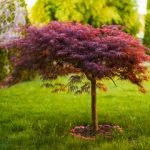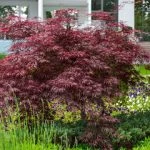Weeping Maples V/S Laceleaf Maples
Japanese maples are renowned for their exquisite foliage and graceful forms, adding a touch of elegance to any garden or landscape. Within the vast world of Japanese maples, two popular varieties stand out: weeping maples and laceleaf maples. While they share a common origin, these maple cultivars possess distinct characteristics that set them apart. In this article, we will explore the unique features and differences between weeping maples and laceleaf maples, unraveling their individual beauty and allure.
- Weeping Maples: Weeping maples, as the name suggests, are known for their cascading branches and pendulous form. Here are some key characteristics that distinguish weeping maples:
a) Graceful Cascading Form: Weeping maples feature slender, arching branches that gracefully drape downwards, creating a stunning weeping effect. This elegant form adds a sense of drama and movement to the landscape.
b) Delicate Foliage: The leaves of weeping maples are typically palmate, meaning they have multiple lobes resembling an open hand. These leaves come in a variety of colors, including vibrant greens, fiery reds, and rich purples, offering a striking contrast against the cascading branches.
c) Size Variations: Weeping maples come in various sizes, ranging from dwarf cultivars suitable for small gardens or containers to larger varieties that can become focal points in spacious landscapes.
- Laceleaf Maples: Laceleaf maples, also known as dissected or thread leaf maples, showcase intricately dissected foliage, adding a delicate and lacy texture to the landscape. Let\'s explore the distinguishing features of laceleaf maples:
a) Fine, Filigree Foliage: Laceleaf maples possess deeply cut or dissected leaves, with each lobe finely divided into slender, thread-like segments. This unique foliage creates a lacy, intricate appearance that is unmatched by other maple varieties.
b) Vibrant Fall Colors: Laceleaf maples exhibit a stunning transformation in autumn, with their finely dissected leaves turning vibrant shades of red, orange, and gold. This autumnal display adds a breathtaking burst of color to the garden.
c) Compact Growth Habit: Laceleaf maples tend to have a more compact and mounding growth habit compared to weeping maples. This makes them an excellent choice for smaller gardens, rockeries, or as focal points in Japanese-inspired landscapes.
Why You Should Choose Weeping Maples?
Let\'s explore what makes weeping maples appealing and worth having-
- Graceful Form:
Weeping maples captivate with their exquisite form and unique branch structure. The branches arch downwards, creating a graceful cascade that adds a sense of movement and visual interest to the landscape. This characteristic shape is a striking departure from the upright or spreading growth habit of many other tree species. - Dramatic Foliage:
One of the defining features of weeping maples is their foliage. The leaves range from vibrant green to deep burgundy, offering a rich and diverse color palette. The foliage is often palmate, with distinct lobes resembling an open hand. This distinctive leaf shape adds to the overall elegance of the tree and contributes to its visual appeal. - Versatility in Size:
Weeping maples come in various sizes, making them suitable for a range of garden spaces. From compact varieties that can thrive in containers or smaller gardens to larger cultivars that become majestic focal points, there is a weeping maple for every landscape. Their size versatility allows for creative placement, whether as a standalone specimen or as part of a larger garden design. - Year-Round Interest:
Weeping maples provide year-round visual interest. In spring, delicate clusters of small flowers may appear, enhancing the tree\'s charm. As summer arrives, the foliage remains vibrant and lush, creating a lush backdrop for other garden elements. When autumn arrives, the leaves often undergo a breathtaking transformation, displaying vibrant hues of red, orange, and gold, adding a blaze of color to the landscape. Even in winter, the weeping form of the branches remains an appealing focal point, especially when adorned with a dusting of snow. - Ideal for Zen and Japanese Gardens:
Weeping maples have a natural affinity for Zen and Japanese-inspired gardens. Their graceful form and tranquil presence evoke a sense of serenity and balance. They pair well with other elements commonly found in these gardens, such as stone pathways, water features, and moss-covered rocks. Incorporating a weeping maple into a Zen garden design can create a harmonious and contemplative atmosphere.
Weeping maples and laceleaf maples represent two distinct yet equally captivating branches within the world of Japanese maples. Weeping Japanese maples impress with their graceful cascading form and delicate foliage, while laceleaf maples enchant with their intricate, filigree-like leaves and vibrant autumn colors. Whether you seek the drama of a weeping maple or the delicate beauty of a laceleaf maple, both varieties offer a unique aesthetic and contribute to the timeless allure of Japanese maple trees. Whichever variety you choose, these exquisite maples are sure to add elegance and charm to your outdoor spaces.




